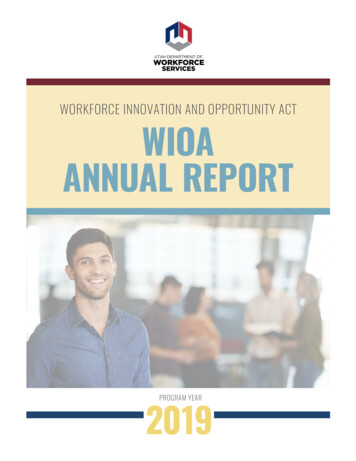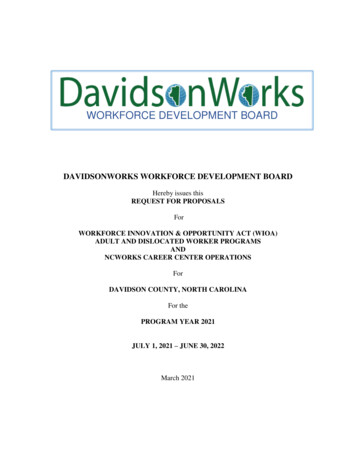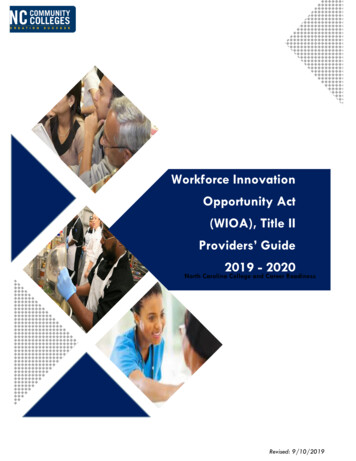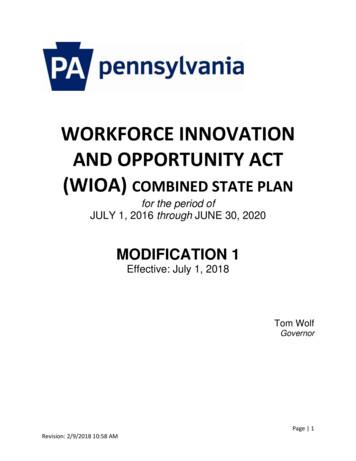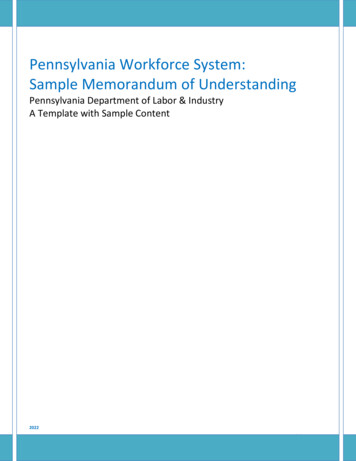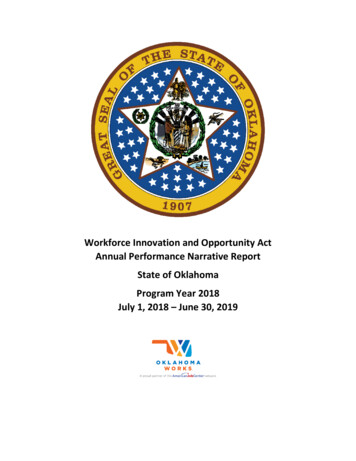
Transcription
Workforce Innovation and Opportunity ActAnnual Performance Narrative ReportState of OklahomaProgram Year 2018July 1, 2018 – June 30, 2019
ContentsExecutive Summary4Research and Evaluation5Completed or Planned Evaluation and Related Research Projects5Oklahoma Works for All Pilot Project5Evaluation of Participant Wage Outcomes6Pay for Performance Feasibility Study6Efforts to Coordinate with WIOA Core Partners, State Agencies and Local BoardsTitle I Staffing Restructure66State Efforts to Provide Data and Survey Responses62019 Talent Pipeline Report62019 Oklahoma Works Business Survey72018 Nursing Professions Issue Brief7My Reemployment Plan Pilot Project7Economic Data Trend Analysis8Provision of Data for Federal Evaluations8Continuous Improvement Strategies8Oklahoma’s Approach to Customer Satisfaction9Customer Satisfaction9Statewide Employer Satisfaction Survey9Local Area Customer Satisfaction and Continuous Improvement9Oklahoma’s Strategic Vision and Goals Progress9Sector Strategies and Career Pathways10Career Pathways10Sector Strategies Partnership Grants10Economic Transition Dislocated Worker Grant11Business Engagement Strategies11Statewide Career Exposure Week11Externships12Local Business Services Coordination12Work-Based Learning12Earn and Learn Oklahoma/Registered Apprenticeships and Internships12Northeast Workforce Development Board (NEWDB) OJT Expansion and Collaboration131
Work Experience for Youth13Oklahoma’s Performance Accountability System13State Specific Performance Measures13Performance Deficiencies on Primary Indicators of Performance14Title I Programs: Oklahoma Office of Workforce Development14Oklahoma’s Common Exit Policy and Continuous Improvement14Negotiated Performance Levels for Title I and III, Program Year 201814Data Validation and Data Integrity14Title I: Oklahoma Office of Workforce Development14Title III: Oklahoma Employment Security Commission15Statewide Activities15Governor’s Reserve Activities and Impact to Performance15Workforce System Accessibility16Rapid Response Activities and Layoff Aversion16Rapid Response Activities16Layoff Aversion16Oklahoma Department of Rehabilitation Services Business Services Program (BSP)17Wagner-Peyser Employment Services17Reemployment Services Delivered to Oklahomans17Reemployment Services and Eligibility Assessment (RESEA)18Unemployment Insurance Meaningful Assistance18Oklahoma Technical Assistance Needs19Promising Practices, Lessons Learned, and Success Stories19Oklahoma’s Accessibility Initiative for the Oklahoma Works System19Oklahoma Accessibility Star Rating System20Out-of-School Youth Outreach20Veteran Hiring Events21Jobs for Veterans State Grants: Oklahoma Employment Security Commission21Annual Oklahoma Works American Job Center Alumni Celebration21National Cohort and Cross-State Academy Participation22Skillful State Network22Participation in the U.S. Department of Labor’s Disability and Employment Cohort22Promising Practices222
Unemployment Insurance Integrity and Fraud Detection22Pay for Performance23Appendices23Appendix I: Negotiated Performance Levels for Title I and III, Program Year 201823Appendix II: Documents of Interest25Appendix III: Local Area Performance and Customer Satisfaction25Appendix IV : State Survey Data253
Executive SummaryThe Oklahoma Office of Workforce Development (OOWD), the Governor’s chosen administrative entityfor Workforce Innovation and Opportunity Act (WIOA) and Title I, and the Oklahoma EmploymentSecurity Commission (OESC), administrative entity for multiple federal programs including Title III, workdiligently to ensure Oklahomans have the skills they need to succeed in the 21st century workplace.Newer partners under WIOA, the Oklahoma Department of Rehabilitation Services (DRS), the sponsor ofthe Title IV Vocational Rehabilitation program, and the Oklahoma Department of Career and TechnologyEducation (ODCTE), the sponsor of Title II Adult Education and Family Literacy Act program, also workdiligently to embed their work in the Oklahoma Works American Job Centers, providing quality servicesto Oklahomans. This Annual Statewide Performance Report Narrative, developed collaboratively by allWIOA Core Partners, includes titles I and III performance.Program Year 2018 (PY18) was a year of transition for the State of Oklahoma. A new Governor’sadministration established new priorities for the state’s workforce system mid-year and the OOWDworked to implement the new vision, while also continuing with the Workforce Innovation andOpportunity Act (WIOA) implementation throughout the state. Additionally, OOWD experiencedvacancies in key research and evaluation staff positions for most of the program year which setOklahoma back in its progress toward research, evaluation and continuous improvement of the state’sworkforce system. However, the vacancy allowed for a staffing restructure that resulted in addedcapacity for these efforts in future program years.Progress toward WIOA implementation continued with the distribution of multiple WIOA compliantpolicies, efforts to better share data needed to analyze and report performance, and theimplementation of continuous improvement strategies aimed at improving services. New and continuinginitiatives under the state’s workforce board, the Governor’s Council for Workforce and EconomicDevelopment, included such things as the expansion and diversification of work-based learning, thestrengthening of sector partnerships, expanded efforts to ensure accessibility of the workforce system,and the creation of a new strategic plan and state evaluation metrics aligned to the Governor’spriorities.During this program year, the entire Oklahoma Works system continued its focus on ensuring individualswith disabilities have equitable access to the services and opportunities offered through the state’spublic workforce system, decreasing improper payments for UI, and completing research to informfuture plans for programmatic and system evaluation.These and other exciting outcomes are shared in the following pages of the Program Year 2018 AnnualReport.4
Oklahoma WaiversOklahoma has no waivers.Effectiveness in Serving EmployersOklahoma piloted all three Effectiveness in Serving Employers approaches established by theDepartments as indicated in the Oklahoma State Plan. Data for the measures is collected by eachprogram and collaboratively reported by the Core Partners. This performance indicator is measured as ashared outcome across all six core programs to ensure a holistic approach to serving employers. Whilepiloting these measures the first year, the State’s employer penetration rate was determined to be low.As a result, Oklahoma took on several continuous improvement strategies. See description below in thesection pertaining to continuous improvement efforts.Approach one, Retention with the Same Employer, addresses each program’s efforts to provideemployers with skilled workers. Oklahoma’s PY18 Retention with the Same Employer rate was 65.3percent, an increase from 62.4 percent in PY17. Approach two, Repeat Business Customers, addresseseach program’s efforts to provide quality engagement and services, and establish productiverelationships with employers and sectors over extended periods of time. Oklahoma expects to have ameasurement for Program Year 2019. Approach three, Employer Penetration Rate, addresses eachprogram’s efforts to provide quality engagement and services to all employers and sectors within thestate and local area’s economy. Oklahoma’s PY18 Employer Penetration Rate was 6.4%, an increasefrom 3.0 percent in PY17. The State credits these strides to continuous improvement strategiesimplemented in the past two program years.Research and EvaluationCompleted or Planned Evaluation and Related Research ProjectsOklahoma Works for All Pilot ProjectPlanning for the Oklahoma Works for All started in Program Year 2017. Work on Oklahoma Works for Allcontinued in Program Year 2018 with specific emphasis on creating evaluation strategies and seekingappropriate Institutional Review Board (IRB) oversight approval (Link to Report). There are two differentevaluation strategies and IRB applications with two components to Oklahoma Works for All. The firstcomponent works with youth ages 16-24 with an intellectual disability (IQ of 70 or below) on training,work experience and customized employment opportunities. The second component focuses ondeveloping Individualized Education Plans (IEPs) for students with intellectual disabilities working withfamilies, caregivers and public schools using the Life Course model to ensure support of their vision for agood life.While a quasi-experimental design is limited and cannot prove causality (i.e., the intervention causedthe change in performance metrics), it will provide critical insight into the potential impact of thecustomized employment pilot. A control time-series design will be used to compare outcomesassociated with pilot participation to outcomes associated with a nonequivalent control groupcomposed of individuals who were deemed eligible for the pilot but did not choose to participate. Again,differences between the two groups could also account for the differences in outcomes. However, this5
design will provide initial insight and baseline data to inform program design with additional datacollected over time.The IEP development component is seeking IRB approval through the University of Oklahoma HealthSciences Center (OUHSC) and led by a principal investigator employed by the Oklahoma StateDepartment of Education and a co-principal investigator employed by OUHSC. The IRBs for the twocomponents are being reviewed in PY19.Evaluation of Participant Wage OutcomesPlanned efforts to evaluate the effectiveness of our programs under the Workforce and InnovationOpportunity Act (WIOA) started in PY18. Data for this project will come from Oklahoma Works’ casemanagement system OKJobMatch and Unemployment Insurance (UI) records. The goal of the study is tomeasure the association of WIOA program participants and wage earnings progression. SinceOKJobMatch includes data for both WIOA participants and non-participants, we will be able to useWIOA non-participant data as a comparison group.Pay for Performance Feasibility StudyOOWD became interested in WIOA’s Pay for Performance contract strategy in PY18. One of therequirements is to conduct a feasibility study prior to engaging in a Pay for Performance contractstrategy. OOWD developed a Request for Proposals (RFP) for Pay for Performance feasibility study andsent to purchasing for review. The RFP approval will be in PY19. The completion of the feasibility studywill conclude in PY19.Efforts to Coordinate with WIOA Core Partners, State Agencies and Local BoardsTitle I Staffing RestructureFor much of PY18, OOWD experienced a vacancy in the position responsible for research and evaluation.This was due to the long-term medical leave and ultimate employment separation of previous staff.Subsequently, OOWD chose to revamp the position to be less focused on basic LMI reporting andinclude more duties centered on research and evaluation to help the OOWD better meet therequirements of WIOA. Near the end of PY18, a new Ph.D. educated, Research and Data Specialist washired to spearhead OOWD’s research and evaluation efforts. Also in PY18, an additional AssistantPerformance and Data Specialist position was created within OOWD to add capacity for performance,evaluation and research functions. The Assistant position will begin work in PY19.As part of the staffing restructure, Research and Data Specialist met with each local board in PY18 todetermine evaluation needs and used that input to develop an evaluation plan and schedule for PY19.Also, with the addition of a new data assistant, the OOWD has added capacity to provide labor marketinformation to local boards who lack the staff capacity to produce those data reports in-house. All ofthese efforts have been undertaken in an effort to better coordinate research, evaluation, and datacollection and reporting with local boards and partners.State Efforts to Provide Data and Survey Responses2019 Talent Pipeline ReportOOWD partnered with the Oklahoma Department of Commerce to release the first annual TalentPipeline Report, which explored the projected growth in the supply of, and the demand for, talent inOklahoma over the next ten years. The report indicates the state is on target to experience a worker6
shortage of nearly 20,000 people by 2028. Factors contributing to this talent gap include an agingpopulation, low workforce participation rates, low educational attainment and low unemployment. Thisreport was used by the State Workforce Board to make policy and strategy recommendations for thecoming years as part of their strategic planning process. It will also be used to inform the 4-year WIOAState Plan.2019 Oklahoma Works Business SurveyOklahoma Works conducted a survey study to evaluate hard to fill positions and their relationships withOklahoma Works and its partners. Representatives from businesses in Oklahoma were invited toparticipate in an online survey. The survey was voluntary and confidential, and 171 responses werereceived. Results indicated a significant moderate relationship (r .39) between difficulty filling highskilled positions and the average time to fill positions. The more skills needed for a position, the moredifficult it is to fill this position. This finding is consistent with anecdotal feedback received fromemployers. Finding talent for high-skilled positions is a challenge in Oklahoma. Approximately 51% ofrespondents reported their level of satisfaction with the services provided by their local workforcedevelopment board and Oklahoma Works American Job Center. A one-sample t-test showed thatbusinesses were significantly more satisfied versus being unsatisfied.2018 Nursing Professions Issue BriefThe Health Workforce Subcommittee of the GCWED released a report of health workforce trends andshortage (Link to report). The report included data showing challenges including: an aging population,expanded health coverage, aging nursing workforce and other economic conditions leading toshortages. The group made several recommendations related to data, recruitment and retention, andmaximizing the talent pipeline. As a result, workplace safety legislation was introduced and a nursingretention pilot program was launched. This report will be used to inform recommendations being madeto the Governor related to his health improvement platform for the upcoming legislative session.My Reemployment Plan Pilot ProjectThe My Reemployment Plan Pilot Project (MRP) was developed by the National Association of StateWorkforce Agencies Information Technology Support Center (ITSC) and started out as a paper tool forUnemployment Insurance (UI) claimants. After many meetings and with substantive feedback from thestates, the tool evolved and is now an online set of reemployment modules designed for any job seekerwho may want to re-tool and prepare a plan for returning to work. The tool is an interactive job searchguide, i.e. a “road map” of sorts. The MRP starts with a short inventory of ‘why you are here or what doyou need’ statements such as: Developing a Plan;Analyzing Your Values and Interests;Assessing Your Knowledge, Skills, and Abilities;Career Exploration;Creating an Effective Resume;Online Job Search and Job Applications;Networking;Acing the Job Interview;Oklahoma Unemployment Information; and7
Other Available Partner and Community Services.Job seekers can upload resumes, save employer and other professional contacts, record weekly worksearch efforts for unemployment, and record other notes that are relevant to getting back to work. Twoof the major advantages of the MRP are: 1) Job seekers can conveniently access their plan, activities,and information from ANY computer that is connected to the internet; and 2) Job seekers can sharetheir plan with workforce professionals at any point during their reemployment journey. This meansreducing the potential duplications and streamlining the service delivery for Oklahoma’s workforce. Yetanother great part of this online tool is its ability to be customized and adapted to the specificrequirements of Oklahoma’s workforce system and its partner agencies. In Program Year 2019, OESC isexploring ways we can ramp up the job seeker participation with the MRP by partnering with the localWorkforce Development Boards.Economic Data Trend AnalysisOESC provided several reports analyzing economic trends, including reports on Changes in Labor ForceParticipation, Rural Oklahoma Health Industry Employment and Earnings, and Oklahoma UnemploymentInsurance Tax Rates by Industry. See appendices for more information. These data reports are also beingused to inform strategy development and future evaluation studies that may be needed.Provision of Data for Federal EvaluationsOklahoma is committed to support all Federal evaluations and will provide data, survey responses, andtimely site visits.Continuous Improvement StrategiesOklahoma is committed to utilizing data to inform strategy development, service delivery, and to makerecommendations to state and local partners on continuous improvement. An example of this isOklahoma’s efforts to improve performance outcomes. In PY17, Oklahoma’s Effectiveness in ServingEmployers performance was low. To improve performance, the State implemented several strategiesaimed at addressing potential challenges and barriers to improvement. First, Oklahoma trained frontlinestaff in PY17 to ensure proper data collection and reporting. Additionally, employer centric focus groupswere held in each of the state’s seven workforce areas to determine needs and barriers to accessingservices through the public workforce system. Then in PY18, the OOWD restructured staff to addcapacity to Business Services. This new structure included the creation of a new position, Director ofPublic-Private Partnerships, with responsibilities for developing and implementing coordinated stateinitiatives and leading a team focused on coordinating partnerships, outreach and business services atthe state and local levels. Also as a part of the staff restructure, the previous State Rapid ResponseCoordinator position was revamped to also include expanded duties for developing and coordinatingstatewide Business Services.Once new staff was in place, additional capacity was added to OOWD’s Business Services team throughresearch and data analysis. In PY18, the state acquired new business intelligence and economic softwareto assist with layoff aversion strategies. Titles I and III also worked together to conduct two separateemployer surveys; one through the state’s labor market exchange, OKJobMatch, and one through thestate’s online UI filing portal. The focus group and survey data were used to inform the development ofa strategic vision for Business Services in Oklahoma. In PY19, the OOWD is convening a Task Force oflocal boards and partner agencies to develop a strategic plan for Business Services in the state, including8
the development of policy, monitoring tools, and performance goals that will help us continue toimprove the Employer Penetration Rate and Repeat Business Customers performance metrics. As aresult of these ongoing efforts, Oklahoma’s Effectiveness in Serving Employers outcomes have improvedand we hope to continue this trend in PY19.Oklahoma’s Approach to Customer SatisfactionCustomer SatisfactionStatewide Employer Satisfaction SurveyThe OOWD (title I) executed an employer survey in partnership with OESC (title III) in an effort tostandardize data gathering from employers in order to inform workforce development. Representativesfrom businesses in Oklahoma completed the survey in January 2018 through the online UI portal and itwas available to all businesses submitting their UI electronically during that month. The survey wasvoluntary and confidential, and 171 responses were collected. Results indicated a significant moderaterelationship (r .39) between difficulty filling high-skilled positions and the average time to fill positions.The more skills needed for a position, the more difficult to fill this position. This finding is consistent withanecdotal feedback received from employers. Finding talent for high-skilled positions is a challenge inOklahoma. Approximately 51% of respondents reported their level of satisfaction with the servicesprovided by their local workforce development board and Oklahoma Works American Job Center. A onesample t-test showed that businesses were significantly more satisfied versus being unsatisfied. Thesedata are being used to inform the state’s strategic planning process for local Business Services delivery.Local Area Customer Satisfaction and Continuous ImprovementDue to previous low response rates, all Local Areas moved to online satisfaction surveys in PY17 in orderto improve customer service within the system and the American Job Centers. Now, every individualthat utilizes center resources has access to and is encouraged to complete a survey. In PY18, local areascontinued to focus on increasing response rates and have undertaken system strategies to achieve thatgoal. Many local areas encourage centers to focus on response rates by sponsoring contests in whichcenter staff win awards like traveling trophies or ‘jeans days’. In PY18, local boards reported receivingmore than 4,000 survey responses with response rates ranging from 5 to 40 percent. See Appendices formore information on local satisfaction surveys.Local areas regularly review survey responses and comments, share that information with partners, andimplement strategies to improve services based on feedback received. Continuous improvement effortsundertaken by local boards and service providers were in direct response to survey results. For example,surveys indicated when customers are asked about how they found out about Oklahoma Works only 3-6percent of respondents each month site referrals from partners. As a result, the Northeast WorkforceDevelopment Board (NEWDB) identified a need for a shared referral tracking system among all requiredpartner agencies. The NEWDB worked extensively with partners in PY18 to implement a referral process,and all but one partner has agreed to the referral process. NEWDB plans to launch the new referralprocess in PY19.Oklahoma’s Strategic Vision and Goals ProgressGovernor’s Council for Workforce and Economic Development Strategic PlanIn PY18, the Governor’s Council for Workforce and Economic Development (GCWED) undertook astrategic planning process. The Oklahoma Works Strategic Plan outlines a statewide strategy for closing9
sizable skill gaps in demand occupations at both the state and local levels. The plan identifies fourobjectives to building a skilled talent pipeline that meets the needs of business and industry:Expanding Oklahoma’s Workforce: An expanded workforce will provide a larger pool of potentialworkers, increase the financial and economic opportunities of workers, and encourage greaterbusiness investment, economic development, and job creation.Upskilling Oklahoma’s Workforce: A well-trained workforce will reduce the incidence and effectsof unemployment, increase the financial and economic opportunities of workers, and encouragegreater business investment and job creation.Offering Workforce Solutions to Oklahoma’s Businesses: Businesses that have access to aresponsive, effective and solutions-focused public workforce system will be better positioned toexpand the availability of quality jobs and capital investments.Building Oklahoma Workforce System Capacity: A public workforce system able to respond tochanging business needs and deliver innovative solutions will support the expansion of businessinvestments and job creation.Through this plan, the GCWED hopes to: increase the state's labor force participation rate; createprivate sector jobs with high salaries; continue to decrease unemployment; and increase the workforcesystem's effectiveness in serving employers.Sector Strategies and Career PathwaysCareer PathwaysOklahoma continued its work in establishing career pathways for its current and future workforce. Oneinitiative of note in PY18 came from the Northeast Workforce Development Board (NEWDB). TheNEWDB and One Stop Operator convened staff from Northeast Tech and Northeastern OklahomaCollege (NEO) Adult Basic Education (ABE) to discuss the launch of a pilot program for Career Pathwaysfor ABE students. This program design exposes current ABE learners to career pathways while earningtheir GED or HiSet. Pathways is a place for adults to consider various demand occupation careerpathways and engage with postsecondary education. The objective of the partnership is to expose theselearners to viable career pathways and help leverage resources to provide linkage to theseopportunities. Through this partnership the NEWDB will provide ABE learners with a viable careerpathway leading to certificates, degrees and credentials. ABE career pathways, in particular, focus onstrengthening connections between ABE and postsecondary education to help more adult learnersacquire a postsecondary credential or degree in high wage occupations. This program will launch inPY19.Sector Strategies Partnership GrantsIn 2018, two Sector Partnership Grants were awarded to three Local Workforce Development Boards(LWDBs), that made up two workforce regions, to support the establishment, strengthening, andexpansion of sector partnerships. Grants were awarded to the Western Planning Region (South Centraland Western Oklahoma LWDBs) and the Northeast LWDB. Both areas focused on the healthcare andadvanced manufacturing industry sectors.10
Through these grants, more than 200 employers were reached through surveys and focus groups toascertain workforce challenges related to hiring and retention; workforce quality; alignment witheducation/training programs; and, industry trends that may affect workforce needs over the next five toten years. As a result, strategies being implemented include the creation of a new online program aimedat increasing the retention rate of nurses, the development of a new Healthcare Workforce AdvisoryCouncil focused on innovation and design of education and employment pathways that are responsiveto the health care needs of the service area, and the development of a new apprenticeship program.Economic Transition Dislocated Worker GrantOESC and its workforce development partners know that we must continue working to narrow the skillsgap. Creating and supporting education and training opportunities will increase productivity in the localeconomy, give a competitive advantage, and contribute to the State’s overall success through employerengagement and industry partnerships. During the year, OESC was awarded an 8,000,000 Trade andEconomic Transition Dislocated Worker Grant from the United States Department of Labor. OESC and itspartners will work together through co-enrollment and other program referral processes to linkdislocated workers with education and training opportunities that are tied to local economies andaligned with the Oklahoma WIOA State Plan. At the same time, we will provide the needed supportiveservices that enable individuals to meet some of the basic requirements that often interfere withcompleting a training program.Program Services Career planning that includes information on demand occupations and career pathways as wellas related Labor Market Information;Development of an Individual Employment Plan outlining goals and following the participant’sprogress through the program;Soft skills workshops (Barriers to Employment, Interview Skills and Etiquette, Job Applications,Job Search, Social Media and Work Search, and Writing Resumes for Today’s Employers);Linkages to community services;Assistance with any of the following: transportation, childcare and dependent care, and housingcosts;Referrals to medical services;Assistance with uniforms or other appropriate work attire and work-related tools includingitems such as eyeglasses and protective eye gear;Assistance with books, fees, school supplies, and other necessary items for students enrolled inpost-secondary education classes; andPayments and fees for employment and training-related applications, tests, and certifications.Business Engagement StrategiesStatewide Career Exposure WeekIn November 2018, Oklahoma hosted the second annual statewide Career Exposure Week. This weeklong event connected students with businesses to give future talent an opportunity to explore thepossibilities that await them in Oklahoma. Events during Career Exposure Week also allowed localemployers to showcase critical careers in demand industries to inspire and recruit new talent. Nearly 50events were registered on our website, taking place in communities across the state, allowing students11
of all ages to tour businesses, shadow professionals from varied industries, and learn about highdemand careers in industries that drive our state’s economy. Through Career Exposure Week, Oklahomahopes to: introduce people to careers in businesses and industries in Oklahoma’s driver andcomplementary ecosystems and critical occupations; empower Oklahoma businesses and industries inthe state’s ecosystems and workforce planning regions to engage with educators, students, parents, andothers about career opportunities; change misconceptions of Oklahoma’s demand and criticaloccupations and the businesses and industries in Oklahoma’s driver and complementary ecosystems;draw attention to the roles businesses and industries play in communities across the state; underscorethe economic and social significance of demand and critical occupations and businesses and industries inOklahoma’s ecosystems, and recognize the important roles apprenticeship, work-based learning, andc
2018 Nursing Professions Issue Brief 7 My Reemployment Plan Pilot Project 7 . The IEP development component is seeking IRB approval through the University of Oklahoma Health Sciences Center (OUHSC) and led by a principal investigator employed by the Oklahoma State Department of Education and a co-principal investigator employed by OUHSC. The .

